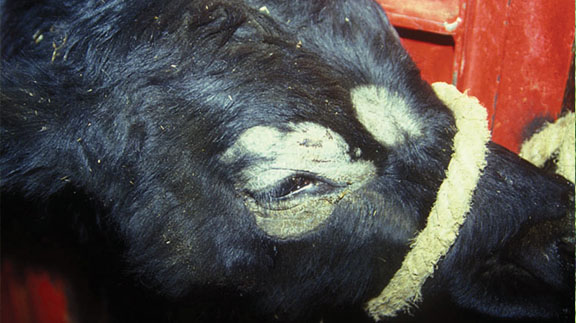Farm & Ranch
Livestock skin diseases

By Jessica Crabtree and
Dr. Jered Harlan, DVM
One of the most common skin diseases in cattle is ringworm. A fungal disease, ringworm often appears on calves and yearlings during winter, but normally vanishes by spring. The fungal skin disease is most often transferred by Trichphyton verrucosum, spore-forming fungi. The highly transmittable, infectious disease can spread from species to species, including humans. The spores, in a dry environment, can live for years. Having so many species of Trichophytin and Microsporum fungi, it is hard to build immunities against them. Direct contact with an infected
animal is the most common form of spreading the infection. Other ways the disease is spread is when an infected animal has rubbed on something in their natural environment such as a rope, halter and other equipment. The fungus establishes itself to the skin of the susceptible animal and is infiltrated through the hair follicle. The best way to halt the spread of the fungus is by disinfecting any equipment used on or around the animals.
Although unattractive, ring worm does not cause economic loss and does little to cause any permanent damage. Most common symptoms associated with the disease include grey-white areas of skin with an ash like surface, usually circular in outline and slightly raised. The size of lesions varies and can become extensive. To read more pick up the September 2015 issue of North Texas Farm & Ranch.
Farm & Ranch
Hazards of Backyard Poultry

By Barry Whitworth, DVM
Having backyard poultry is a popular agriculture enterprise. According to the United States Department of Agriculture, 0.8 percent of all households in the United States have chickens. People keep chickens for a variety of reasons with table eggs being one of the more common reasons.
Unfortunately, some of these poultry producers are not aware of the hazards that come with keeping poultry because many times they carry pathogens but appear healthy.
Chickens are carriers of several zoonotic diseases. These are diseases that can be passed from animals to humans. According to a recent survey in Pennsylvania, a majority of backyard poultry producers were aware of the dangers of avian influenza. However, this study also revealed that far fewer producers were aware of the risk of possible exposure to Salmonella and Campylobacter.
The lack of knowledge about the hazards of raising poultry likely contributes to the continued issues of Salmonella outbreaks associated with backyard poultry. In 2023, the Centers for Disease Control and Prevention reported 1,072 illnesses of Salmonella linked to backyard poultry, and 272 of those patients required hospitalization. Oklahoma reported 43 individuals with the disease.
To read more, pick up a copy of the April issue of NTFR magazine. To subscribe by mail, call 940-872-5922.
Farm & Ranch
Ag Elsewhere: Wyoming

By Tressa Lawrence
Babies are tucked away in every nook and cranny. Many ranchers across Wyoming have baby animals popping up all over this time of year.
Farm & Ranch
Ag Elsewhere: Montana

By Lindsey Monk
Another load of grain in to keep feeding the calves until the green grass can really start popping.
-

 Country Lifestyles1 year ago
Country Lifestyles1 year agoScott & Stacey Schumacher: A Growth Mindset
-

 Equine7 months ago
Equine7 months agoThe Will to Win
-

 Country Lifestyles7 years ago
Country Lifestyles7 years agoStyle Your Profile – What your style cowboy hat says about you and new trends in 2017
-

 Country Lifestyles4 years ago
Country Lifestyles4 years agoAmber Crawford, Breakaway Roper
-

 HOME7 years ago
HOME7 years agoGrazing North Texas – Wilman Lovegrass
-

 Country Lifestyles7 years ago
Country Lifestyles7 years agoDecember 2016 Profile, Rusty Riddle – The Riddle Way
-

 Country Lifestyles8 years ago
Country Lifestyles8 years agoJune 2016 Profile – The man behind the mic: Bob Tallman
-

 Outdoor9 years ago
Outdoor9 years agoButtercup or Primrose?






